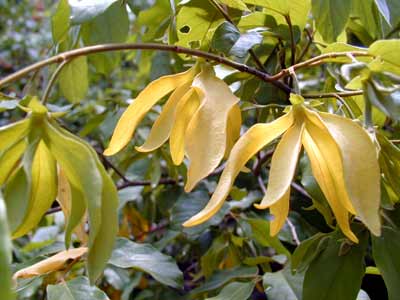|

|
|
Sai Yood |
Cananga odorata, which is the “champion of sweet flowers”, has become
well known in all over the world; however, its sister flower, sai yood – remains unknown to the outside world until up to the present. As a matter of fact, it is also a sweet flower that has great potentials for commercial development.
Sai yood is a kind of standing or climbing shrub. It is wild originally, but the later transplantation indicates: it has strong ability in adaptation. It grows very quickly, it blooms early, and it would begin to bloom in 2-3 years; within 4-5 years, its flowers can be collected; however, its the blossom period is centralized. The flowers of
Cananga odorata are big, its shrubs are short, which make collection quite easy. The aroma of it is similar to that of
Cananga odorata, and the flower can be used to make essence, cosmetics, and soaps etc. Its oil output rate is 0.36-0.45%, and the rate for dried flowers is 1.33 – 1.75%.
Sai yood is beautiful and has strong aromas. Its aroma can last a very long period of time. If one tree is in blossom, the whole yard is full of fragrance. When the blooming season comes, its milk yellow flowers would grow on the forks and small twigs, they are very beautiful and are loved by many people. The local girls all like collecting sai yood flowers. The girls would wrap the flowers in their handkerchiefs, or put them in letters and send the letters to their lovers. Some girls may piece the flowers into garlands and put them on when going out. The flowers can be used for decorations and they have the effect to drive away mosquitoes and flies. The fruits of sai yood are like a string of pearls, and they may change form red into purple, which are especially good looking.
Besides distilling perfume oil, sai yood has many other uses: its roots and leaves can be used as medicines, which can cure rheumatism and indigestion etc; its stalk fibers can be used to make ropes, or raw materials for making paper and textiles. In Hainan Island, some people use its leaves to distill liquors. Moreover, since sai yood has beautiful shapes, it is also an ideal ornamental flower and plant for forestation.
Sai yood mainly scatters in Canton, Hainan, Guangxi, Yunnan and Guizhou etc. in China, and there are also some in Vietnam, Malaysia and India. In Yunnan province, the flower mainly scatters in Wenshan, Honghe and Xishuangbanna and is mostly planted in open fields, roadsides and shrubs in mountain valleys.


|